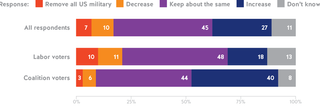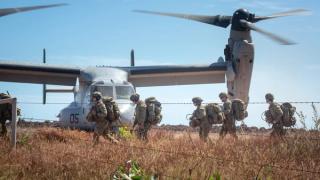This month marks 11 years since Australian Prime Minister Julia Gillard and US President Barack Obama announced the ‘United States Force Posture Initiatives (USFPI)’. The rapid pace of China’s military modernisation and long-range strike capabilities, as well as a lack of firm military access points throughout the Indo-Pacific outside of Japan and South Korea, has seen renewed US interest in Australia’s Top End. The late scholar Desmond Ball once described Australia as a “suitable piece of real estate” for US global strategy, but how politically sustainable is the US military presence in Australia? As Australia deepens its alliance with the United States in unprecedented ways, it is worth asking what the Australian public will, and will not, support.
The USFPI are an enhancement of Australia’s alliance with the United States that encompass a range of bilateral defence cooperation activities but are best known to the public through the US Marines in Darwin. The first of the Initiatives sees up to 2,500 US Marines visit the Northern Territory each year during the Top End’s dry season from March to October as part of Marine Rotational Force-Darwin (MRF-D). During their stay, MRF-D trains with Australian troops to respond to humanitarian crises and natural disasters and also conducts military exercises with our regional partners.
The late scholar Desmond Ball once described Australia as a “suitable piece of real estate” for US global strategy, but how politically sustainable is the US military presence in Australia?
The second of the Initiatives involves the rotational deployment of US military aircraft under the Enhanced Air Cooperation (EAC). This was most recently highlighted by the media interest in defence infrastructure upgrades across Northern Australia to host a range of US aircraft, including eventually B-52 bombers. Other projects include strengthening airfields, accommodation facilities for US troops, new combat training grounds, jet fuel storage facilities, and ammunition bunkers.
The USFPI has largely been a boon for Australia’s Top End communities, who have benefited from government infrastructure investment and employment opportunities servicing the visiting forces. For example, the 2022 Lowy Institute poll found that an overwhelming 90 per cent of Northern Territorians were either “strongly” or “somewhat in favour” of allowing the United States to base military forces in Australia, up from 76 per cent in 2011. At the same time, the percentage of Northern Territorians "strongly in favour" of hosting US military forces has steadily fallen since 2011, from 60 per cent to only 26 per cent in 2022, with most people instead shifting to "somewhat in favour".
Australian public support for the US military presence
With Australia-US military cooperation set to significantly expand in the coming years under the USFPI as well as partnerships like the Quad and AUKUS, what is the public appetite for hosting a larger US military presence on Australian soil? As part of the October 2022 United States Studies Centre survey of the Australian, American and Japanese publics on a range of political, security, and economic issues ahead of the US midterm elections, Australian respondents were asked the following question: “Currently, Australia gives the United States access to Australian defence facilities, such as the rotation of 2,500 US Marines in Darwin. Should Australia…” remove all US military, decrease, keep the same, or increase?
While Labor (48 per cent) and Coalition (44 per cent) voters both support the status quo in similar numbers, there is a significant difference when it comes to the matter of a troop increase, with only 18 per cent of Labor voters in support compared to 40 per cent of Coalition voters.
The results indicate that the plurality of Australian respondents are in fact inclined toward maintaining the status quo of 2,500 US troops. While Labor (48 per cent) and Coalition (44 per cent) voters both support the status quo in similar numbers, there is a significant difference when it comes to the matter of a troop increase, with only 18 per cent of Labor voters in support compared to 40 per cent of Coalition voters. Notably, 21 per cent of Labor voters and nine per cent of Coalition voters wanted US troops to either decrease or be removed altogether.
This is an important distinction. The rest of the survey shows strong public support for the United States and partnerships like AUKUS, as well as a clear recognition of the intensifying strategic challenges presented by China. At the same time, less than a third of the Australian public support increasing the current US military presence in Australia.
The social license for sustainable presence
As Deputy Prime Minister Marles declared earlier this month, “Gone are the days of simply paying the entry price to obtain our security guarantee from our security guarantor.” The next decade of the USFPI will likely see further expansion in activities and cooperation between the United States and Australia. There will be more US military personnel in our cities and regions on visits, training and exercises. The American and British accents of technicians working on the AUKUS submarines and military capabilities will likely soon be heard in pubs from Port Adelaide to Fremantle. Australians should expect US fighter aircraft, bombers, warships, submarines and aircraft carriers to make regular appearances at our airfields and ports, and not just in the dry season.
The USFPI are unlikely to ever lead to the kind of US military footprint found in places like South Korea or Japan, which host 28,500 and 56,000 US troops, respectively. Australian governments have maintained a “long standing policy that there are no foreign military bases on Australian soil”, as affirmed by the Joint Standing Committee on Treaties’ review of the 2014 Force Posture Agreement that gave legal authority to the USFPI.
The Australian people rightly expect that as the Australian Government updates the USPFI and expands its alliance with the United States, it will constantly renew the social license that makes alliance cooperation possible.
What the Centre’s recent survey shows, however, is that once we look beyond the headline figure of public sentiment, there are important caveats and conditions that the Australian public implicitly holds. While these results suggest that there is a tentative ceiling to the US troop numbers the public currently support, more research is needed to identify how support might change under different threat scenarios in the coming years. More work also needs to be done to understand what types of US military capabilities the Australian public supports rotating through the country and which it opposes.
When the USFPI were first announced in November 2011, Prime Minister Gillard and President Obama stated it was to pursue a “more geographically distributed, operationally resilient and politically sustainable military presence in this region.” The political sustainability of the US military presence depends on Australian public support. As US President Abraham Lincoln once proclaimed, “public sentiment is everything. With public sentiment, nothing can fail; without it nothing can succeed.” The Australian people rightly expect that as the Australian Government updates the USPFI and expands its alliance with the United States, it will constantly renew the social license that makes alliance cooperation possible.
Australian and Japanese support for US troops in their nations
Australians were asked, “Currently, Australia gives the United States access to Australian defence facilities, such as the rotation of 2,500 US Marines in Darwin. Should Australia...”







